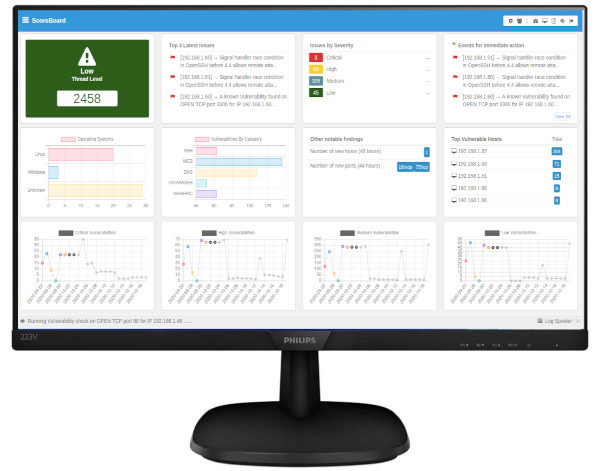|
Artificial Intelligence Shield
Your Guardian Against Phishing Threats !
Why use an Autonomous Phishing Security Awareness Training Platform with Artificial Intelligence (A.I) ?Using an Autonomous Phishing Security Awareness Training Platform like ASATP with A.I has several advantages over manually sending phishing emails to users. Here are some reasons why organizations prefer automated systems: Adaptive Learning: AI-powered systems can adapt and evolve based on user responses over time. This adaptive learning allows the simulation to become more sophisticated, adjusting the difficulty of scenarios to the skill level of the users. This personalized approach enhances the overall effectiveness of the training. Real-time Threat Intelligence: AI can leverage real-time threat intelligence to simulate the latest phishing techniques and tactics used by cybercriminals. This ensures that simulations stay relevant and reflect current cybersecurity threats, providing a more accurate representation of potential real-world scenarios. Behavioral Analysis: AI can analyze user behavior during phishing simulations more comprehensively. By considering various factors, such as response times, interaction patterns, and decision-making processes, AI can provide a nuanced understanding of user vulnerabilities. This information helps organizations tailor their training programs to address specific weaknesses. Dynamic Simulation Scenarios: AI enables the creation of dynamic and unpredictable phishing scenarios. This mimics the constantly evolving nature of cyber threats. Users are exposed to a variety of simulated attacks, preventing them from becoming complacent and promoting a proactive security mindset. Automated Remediation Suggestions: AI can automatically generate remediation suggestions based on user behavior. This feature provides immediate guidance to users who fall for phishing simulations, offering educational content, tips, and best practices to enhance their awareness and resilience against future attacks. Continuous Improvement: AI's ability to analyze large datasets allows organizations to continuously improve their security awareness training programs. Insights gained from AI-driven analytics can inform the refinement of training content, delivery methods, and overall security policies. Reduced Administrative Burden: AI automation reduces the administrative burden associated with managing phishing simulations. From scenario creation to result analysis, AI can handle various tasks autonomously, allowing security teams to focus on strategic planning and response rather than routine operational tasks. Controlled Environment: Automated phishing simulation systems allow you to create and execute phishing campaigns in a controlled and safe environment. This ensures that the simulation is realistic but without the risks associated with actual phishing attacks. Scalability: Automated systems make it easier to scale phishing simulations to a large number of users. This is particularly important for organizations with a significant user base, as manual testing could be time-consuming and impractical. Consistency: Automated systems ensure consistency in the way phishing scenarios are presented to users. This is crucial for accurately assessing the organization's overall susceptibility to phishing attacks. Metrics and Reporting: Automated systems provide detailed metrics and reporting on user behavior, allowing organizations to analyze the effectiveness of their security awareness training programs. This data can be valuable for identifying trends, weaknesses, and areas for improvement. Customization: Automated systems often offer the ability to customize phishing scenarios based on the organization's specific needs and industry threats. This flexibility is beneficial for tailoring simulations to the unique risks faced by the organization. Efficiency: Automated systems are generally more efficient than manual methods, saving time and resources. They can schedule and execute simulations at specific times, track user responses, and generate reports without the need for constant manual oversight. Compliance: Many compliance standards and regulations require organizations to conduct regular security awareness training, including phishing simulations. Automated systems help organizations meet these compliance requirements more effectively. Security Awareness Training Integration: Automated phishing simulation platforms are often integrated with broader security awareness training programs. This integration enables organizations to provide immediate feedback and educational resources to users who fall for simulated phishing attacks. It's important to note that while automated systems offer numerous benefits, they should be used responsibly and ethically. Clear communication with employees before and after simulations is essential to maintain a positive and constructive approach to security awareness training. While the integration of AI adds sophistication to phishing simulation systems, it's crucial to emphasize the responsible and ethical use of AI technologies. Organizations should prioritize transparency, user privacy, and clear communication throughout the training process.
|
|
|
Artificial Intelligence Shield
Your Guardian Against Phishing Threats !
Why use an Autonomous Phishing Security Awareness Training Platform with Artificial Intelligence (A.I) ?Using an Autonomous Phishing Security Awareness Training Platform like ASATP with A.I has several advantages over manually sending phishing emails to users. Here are some reasons why organizations prefer automated systems: Adaptive Learning: AI-powered systems can adapt and evolve based on user responses over time. This adaptive learning allows the simulation to become more sophisticated, adjusting the difficulty of scenarios to the skill level of the users. This personalized approach enhances the overall effectiveness of the training. Real-time Threat Intelligence: AI can leverage real-time threat intelligence to simulate the latest phishing techniques and tactics used by cybercriminals. This ensures that simulations stay relevant and reflect current cybersecurity threats, providing a more accurate representation of potential real-world scenarios. Behavioral Analysis: AI can analyze user behavior during phishing simulations more comprehensively. By considering various factors, such as response times, interaction patterns, and decision-making processes, AI can provide a nuanced understanding of user vulnerabilities. This information helps organizations tailor their training programs to address specific weaknesses. Dynamic Simulation Scenarios: AI enables the creation of dynamic and unpredictable phishing scenarios. This mimics the constantly evolving nature of cyber threats. Users are exposed to a variety of simulated attacks, preventing them from becoming complacent and promoting a proactive security mindset. Automated Remediation Suggestions: AI can automatically generate remediation suggestions based on user behavior. This feature provides immediate guidance to users who fall for phishing simulations, offering educational content, tips, and best practices to enhance their awareness and resilience against future attacks. Continuous Improvement: AI's ability to analyze large datasets allows organizations to continuously improve their security awareness training programs. Insights gained from AI-driven analytics can inform the refinement of training content, delivery methods, and overall security policies. Reduced Administrative Burden: AI automation reduces the administrative burden associated with managing phishing simulations. From scenario creation to result analysis, AI can handle various tasks autonomously, allowing security teams to focus on strategic planning and response rather than routine operational tasks. Controlled Environment: Automated phishing simulation systems allow you to create and execute phishing campaigns in a controlled and safe environment. This ensures that the simulation is realistic but without the risks associated with actual phishing attacks. Scalability: Automated systems make it easier to scale phishing simulations to a large number of users. This is particularly important for organizations with a significant user base, as manual testing could be time-consuming and impractical. Consistency: Automated systems ensure consistency in the way phishing scenarios are presented to users. This is crucial for accurately assessing the organization's overall susceptibility to phishing attacks. Metrics and Reporting: Automated systems provide detailed metrics and reporting on user behavior, allowing organizations to analyze the effectiveness of their security awareness training programs. This data can be valuable for identifying trends, weaknesses, and areas for improvement. Customization: Automated systems often offer the ability to customize phishing scenarios based on the organization's specific needs and industry threats. This flexibility is beneficial for tailoring simulations to the unique risks faced by the organization. Efficiency: Automated systems are generally more efficient than manual methods, saving time and resources. They can schedule and execute simulations at specific times, track user responses, and generate reports without the need for constant manual oversight. Compliance: Many compliance standards and regulations require organizations to conduct regular security awareness training, including phishing simulations. Automated systems help organizations meet these compliance requirements more effectively. Security Awareness Training Integration: Automated phishing simulation platforms are often integrated with broader security awareness training programs. This integration enables organizations to provide immediate feedback and educational resources to users who fall for simulated phishing attacks. It's important to note that while automated systems offer numerous benefits, they should be used responsibly and ethically. Clear communication with employees before and after simulations is essential to maintain a positive and constructive approach to security awareness training. While the integration of AI adds sophistication to phishing simulation systems, it's crucial to emphasize the responsible and ethical use of AI technologies. Organizations should prioritize transparency, user privacy, and clear communication throughout the training process.
|




 Login
Login Sign Up
Sign Up

